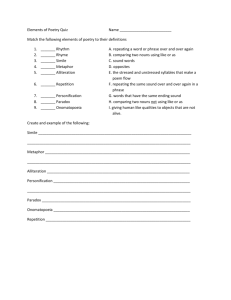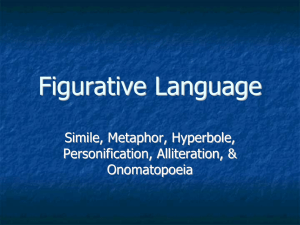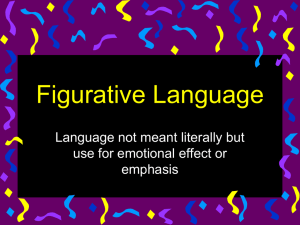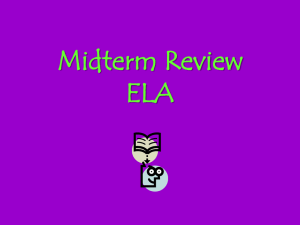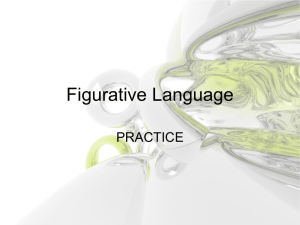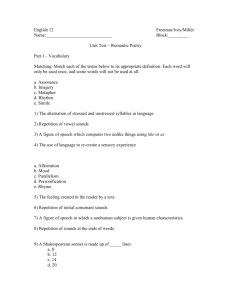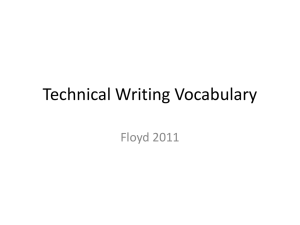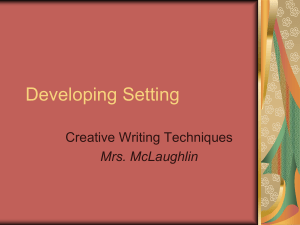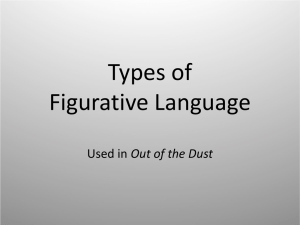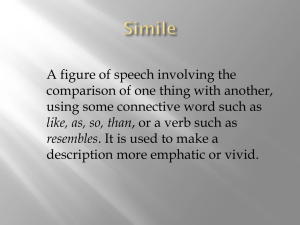Figurative Language: Types & Examples
advertisement
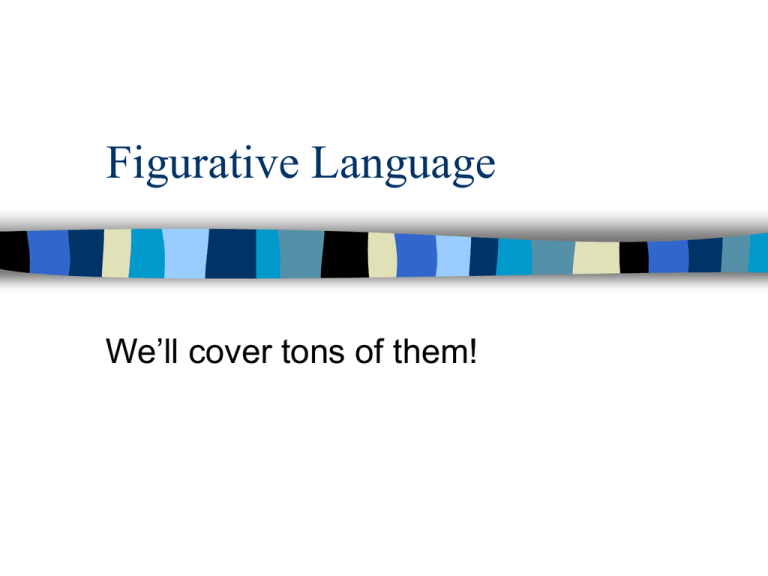
Figurative Language We’ll cover tons of them! We’ll cover these: Alliteration Hyperbole Metaphor Simile Onomatopoeia Personification Parody Synecedoche Idiom Irony Juxtaposition Oxymoron Paradox Parallelism Repetition Allusion Pun Satire Aphorism Connotation/denotation Assonance/Consonance Alliteration Alliteration happens when the beginning of words start with the same consonant or vowel sounds. All the words must be close together. Alliteration Examples: Sally Sold seven sea shells at the sea shore. The crazy cat climbed up the crooked cable. Hyperbole Hyperbole is a figure of speech that uses exaggeration to give a certain impact within your statement. You use these a million times a day! Hyperbole Examples: Sounds like a herd of buffalo! Working like a dog! She’s madder than an old wet hen! I bit off more than I can chew! Metaphor A metaphor is a figure of speech that compares dissimilar objects that are alike in some way. They help create a clearer picture. DO NOT use these words: like, as, than, similar to and resembles. Metaphor Examples: That guy is a motor mouth. Means that guy is never quiet That athlete is a powerhouse. Means the athlete is strong Simile A simile is a figure of speech which resembles a metaphor but uses these words: like, as, than, similar to. Simile Examples: The lie formed like a blister on his lips. Means: he lied and it was ugly. Her heart was like a shattered light bulb. Means: she was heart-broken. Onomatopoeia Onomatopoeia is the usage of word which best demonstrates the sound it makes. Comics are a good resource to find these “sound words” such as: crash, boom, bang, crunch, kerplunk, zap and buzz. Onomatopoeia Examples: The water gurgled down the drain. The little kid slurped his soup. The noisy chicken clucked her head off! Personification Personification is a figure of speech which uses a strategy to give objects, things or animals human characteristics which we recognize in ourselves. Personification has the root word “person” to give you a clue as to how this figure of speech was developed. Personification Examples: The camera hates me. Means: I take an awful picture. Technology is out to get me! Means: I can’t get it to work when I want it to. Oxymoron A two to three word phrase that contains opposite words or ideas Example: Wise fool Working Vacation Plastic Glasses Paradox An extended oxymoron. It pits contradictory ideas against one another so that the statement appears to be untrue. However, when the reader evaluates a paradox in context, he or she discovers the paradox to hold a profound truth. Paradox Example: “Good men must not obey the laws too well.” Ralph Waldo Emmerson “Much Madness is Divinest Sense” Emily Dickinson Parallelism It the repetition of words, phrases or sentence structures. It adds It adds rhythm and emotional impact to writing. It appears in poetry, speeches, and other literary forms. Parallelism Ex. Not only is she my mother, but she is also my best friend. …not only, but also I need her to love me, to comfort me, and to protect me. Repetition Words or phrases repeated in writing to produce emphasis, rhythm, and/or sense of urgency. Ex. The cook was a good cook, as cooks go; and as cooks go, she went. “I…I…I…don’t have Mme. Forestier’s necklace.” Allusion A reference made to a famous person, place, or event. Allusions should be familiar to the author’s intended audience for them to be effective. Allusions… Mary said, “Cale is my Prince Charming!” Kevin doesn’t do so well in math, but in art class, he’s a regular Picasso. Pun…a play on words People have a happy time vacationing in Ireland because they are walking on Eire. In the winter my dog wears his coat, but in the summer he wears his coat and pants. Satire Writing that makes fun of habits, ideas, or weaknesses in a person, an institution, an entire society, or humanity in general. Ex. Weird Al Yankovic’s songs Parody Writing that makes fun of a piece of literature, art or music. Ex. Saturday Night Live creates parodies of famous people, commercials, etc. Synecdoche a figure of speech in which the word for part of something is used to mean the whole, e.g. "sail" for "boat," or vice versa bread for food, the army for a soldier, or copper for a penny Aphorism Is any general truth conveyed in a short and pithy sentence, in such a way that when once heard it is unlikely to pass from memory. Example: He who rocks the boat seldom has time to row it. Idiom A phrase common to people who speakt he same language that doesn’t literally mean what it says. Ex. Cat got your tongue Ex. Two Peas in a Pod Irony Is a contradictory statement or situation Ex: Having a free ride on roller coaster after you have already paid. Song Lyrics to “Ironic” by Alanis Morissette Juxtaposition Is two random objects moving in parallel Ex. Connotation Is the thoughts, feelings, and images associated with a word. Ex. Americaconnotes freedom, individualism, and opportunity. Denotation Is the dictionary definition of a word Ex. Americadenotes the country south of Canada and north of Mexico. Assonance Is the repetition of vowel sounds at the beginning, middle, or end of a word. Ex. He is all pine, and I apple orchard (a sound) Consonance Is the repetition of consonant sounds anywhere within a word. Ex. Lies stretching to my dazzled sight/ A luminous belt, a misty light (s and l sounds)
